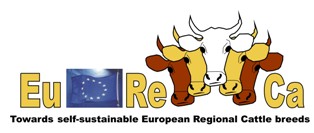Dual-Purpose Belgian Blue Breed
 |
|
History
During the latter part of the 19th century local Belgian, mostly black and white, dairy cattle were crossed with Shorthorns, origin of the roan pattern of the breed. At the beginning of the 20th century crossbreeding stopped and until the 1950s selection was strongly focused on milk. Milk recordings from this period indicate that these cattle were producing to similar levels than did contemporary Friesian cattle. The breeding objective was a dual-purpose breed, rectangular, with good format and musculature and good milking yield (4000 kg, 3,5% fat).Between 1950 and 1970 gradually meat production became more important, and most breeders gave preference to muscular development, discarding milk production. Due to this new direction in selection, the decision was taken in 1974 to create two separated lines, called the Meat Belgian Blue Breed and the Dual-Purpose Belgian Blue Breed (DP-BBB).
During the next years DP-BBB became less and less popular, the number of purebred milk recorded females in Walloon Region decreased rapidly from about 10000 at the end of the 1970s to less than 300 in 1995. Nowadays, with the support of some conservation actions, registered population increased to reach 3205 registered milk recorded females in Walloon Region in 2006. Of these animals 958 have a known DP-BBB pedigree, the remainder is registered according to phenotype. DP-BBB animals are kept in the Walloon Region (3/4 of the population, mostly in the Hainaut province), the remaining being in the Flemish Region around Brussels. A small population of genetically related animals is present in North of France, where its breed is called “Bleue du Nord”.
Breed Description
The current breeding objective is to produce meat and milk with a functional animal, that is easy to manage and that is adapted to local conditions.The current mean size and weight of females are 1,35 m and 700 kg, and their milk production is around 4000 kg at 3,48% fat and 3,23% protein. Muscularity of animals is highly dependant of presence of the myostatin mutation (called mh) responsible for double muscling. This mutation is admitted in DP-BBB and in 2006 20% of genotyped animals were +/+, 37% mh/+ and 43% mh/mh. Studies are ongoing to describe impact of mh on economically important traits as milk and beef performances of DP-BBB. Calving ease always received an important weight in breeding goal in order to limit the 30% of births realized through cesarean section, mainly for mh/mh calves.
Previous/Future conservation action(s)
1998 ~ ongoing: Walloon Region agri-environmental policy (with support of EAGGF) : financial support for registration and keeping of DP-BBB cows.September 2005 ~ April 2007: Walloon Region support for development of an adapted selection program, organized by Walloon Breeding Association.
Planned: Development of a working group for transborder (Walloon-Flandres-France) selection in BBM and "Bleue du Nord".
Contact
Belgian Blue Herd-Book: rue des champs Elysées 4, 5590 Ciney BELGIUM.Walloon Breeding Association (AWE) : rue des champs Elysées 4, 5590 Ciney BELGIUM.
Contact person: Patrick Mayeres (pmayeres@awenet.be)


